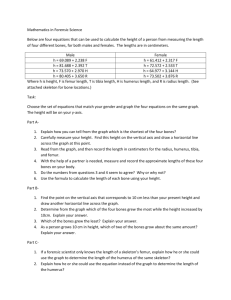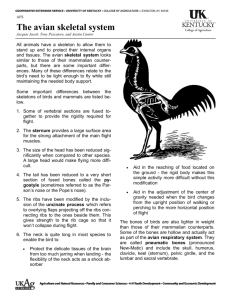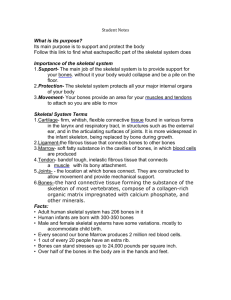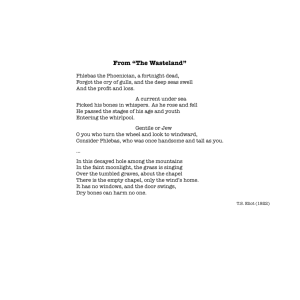Avian Skeletal System - UK College of Agriculture
advertisement
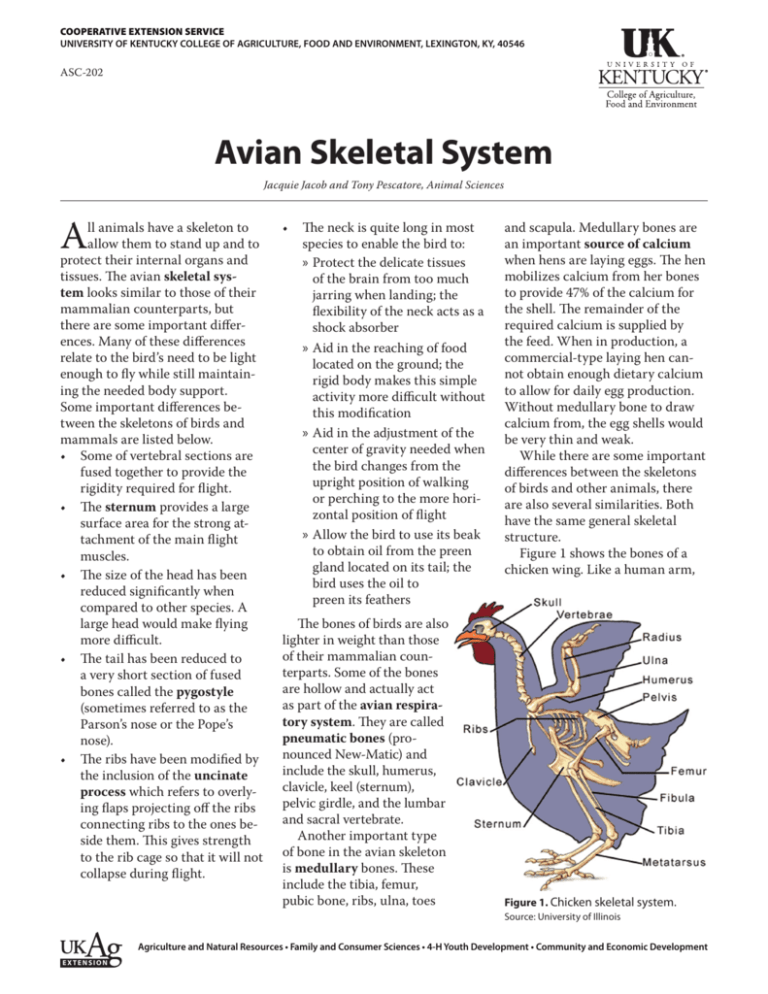
COOPERATIVE EXTENSION SERVICE UNIVERSITY OF KENTUCKY COLLEGE OF AGRICULTURE, FOOD AND ENVIRONMENT, LEXINGTON, KY, 40546 ASC-202 Avian Skeletal System Jacquie Jacob and Tony Pescatore, Animal Sciences A ll animals have a skeleton to allow them to stand up and to protect their internal organs and tissues. The avian skeletal system looks similar to those of their mammalian counterparts, but there are some important differences. Many of these differences relate to the bird’s need to be light enough to fly while still maintaining the needed body support. Some important differences between the skeletons of birds and mammals are listed below. • Some of vertebral sections are fused together to provide the rigidity required for flight. • The sternum provides a large surface area for the strong attachment of the main flight muscles. • The size of the head has been reduced significantly when compared to other species. A large head would make flying more difficult. • The tail has been reduced to a very short section of fused bones called the pygostyle (sometimes referred to as the Parson’s nose or the Pope’s nose). • The ribs have been modified by the inclusion of the uncinate process which refers to overlying flaps projecting off the ribs connecting ribs to the ones beside them. This gives strength to the rib cage so that it will not collapse during flight. • The neck is quite long in most species to enable the bird to: »» Protect the delicate tissues of the brain from too much jarring when landing; the flexibility of the neck acts as a shock absorber »» Aid in the reaching of food located on the ground; the rigid body makes this simple activity more difficult without this modification »» Aid in the adjustment of the center of gravity needed when the bird changes from the upright position of walking or perching to the more horizontal position of flight »» Allow the bird to use its beak to obtain oil from the preen gland located on its tail; the bird uses the oil to preen its feathers The bones of birds are also lighter in weight than those of their mammalian counterparts. Some of the bones are hollow and actually act as part of the avian respiratory system. They are called pneumatic bones (pronounced New-Matic) and include the skull, humerus, clavicle, keel (sternum), pelvic girdle, and the lumbar and sacral vertebrate. Another important type of bone in the avian skeleton is medullary bones. These include the tibia, femur, pubic bone, ribs, ulna, toes and scapula. Medullary bones are an important source of calcium when hens are laying eggs. The hen mobilizes calcium from her bones to provide 47% of the calcium for the shell. The remainder of the required calcium is supplied by the feed. When in production, a commercial-type laying hen cannot obtain enough dietary calcium to allow for daily egg production. Without medullary bone to draw calcium from, the egg shells would be very thin and weak. While there are some important differences between the skeletons of birds and other animals, there are also several similarities. Both have the same general skeletal structure. Figure 1 shows the bones of a chicken wing. Like a human arm, Figure 1. Chicken skeletal system. Source: University of Illinois Agriculture and Natural Resources • Family and Consumer Sciences • 4-H Youth Development • Community and Economic Development EXTENSION it has a humerus, radius, and ulna. The main difference is that the phalanges that make up the fingers of people are fused in birds to allow for the attachment of feathers. The common joints of the arm are easily identifiable in both the chicken and humans. • Joint between humerus and scapula = shoulder • Joint between humerus and radius/ulna = elbow • Joint between radius/ulna and metacarpus = wrist. Similarly, a chicken leg and human leg both have a femur, fibula, and tibia. The femur of a chicken holds the thigh meat while the fibula/tibia combination holds the meat of the drumstick. Comparing the leg joints is not quite as obvious as with the arm. • Joint at the top of the femur = hip • Joint between femur and the fibula/tibia = knee • Joint between fibula/tibia and the metatarsus = ankle The metatarsus of a bird is known as the shank. Birds walk up on their toes. Summary Aside from the obvious role of structural support, the avian skeletal system has two additional functions: respiration and calcium transport. The avian skeletal system is compact and lightweight, yet strong. The tail and neck vertebrae are movable, but the body vertebrae are fused together to give the body sufficient strength to support the wings. There are two special types of bones which make up the avian skeletal system: the pneumatic and medullary bones. The pneumatic bones are important to birds for respiration. They are hollow bones which are connected to the bird’s respiratory system and are important for birds to be able to breath. Examples of pneumatic bones are the skull, humerus, clavicle, keel (sternum), pelvic girdle, and the lumbar and sacral vertebrae. The medullary bones are an important source of calcium for the laying hen. Calcium is the primary component of egg shells and a hen mobilizes 47 percent of her body calcium to make an egg shell. Examples of medullary bones are the tibia, femur, pubic bones, ribs, ulna, toes, and scapula. Educational programs of Kentucky Cooperative Extension serve all people regardless of race, color, age, sex, religion, disability, or national origin. Issued in furtherance of Cooperative Extension work, Acts of May 8 and June 30, 1914, in cooperation with the U.S. Department of Agriculture, M. Scott Smith, Director, Land Grant Programs, University of Kentucky College of Agriculture, Food and Environment, Lexington, and Kentucky State University, Frankfort. Copyright © 2013 for materials developed by University of Kentucky Cooperative Extension. This publication may be reproduced in portions or its entirety for educational or nonprofit purposes only. Permitted users shall give credit to the author(s) and include this copyright notice. Publications are also available on the World Wide Web at www.ca.uky.edu. Issued 11-2013 Image with permission from the University of Illinois.
